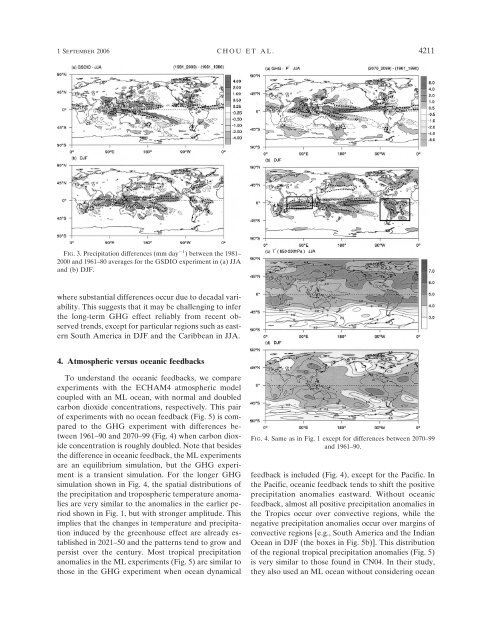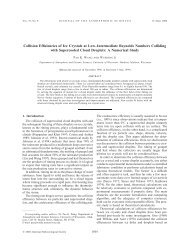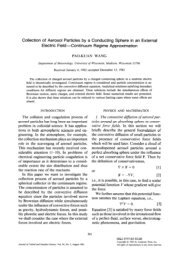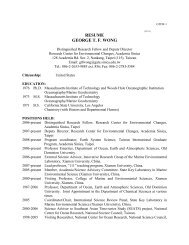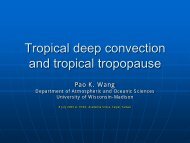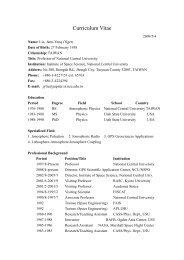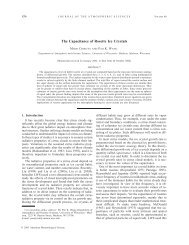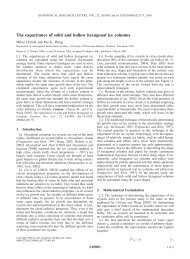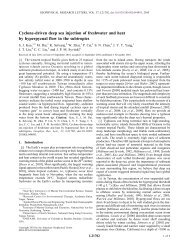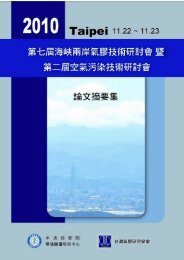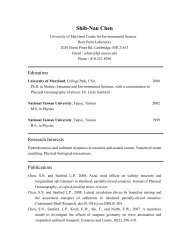Regional Tropical Precipitation Change ... - Academia Sinica
Regional Tropical Precipitation Change ... - Academia Sinica
Regional Tropical Precipitation Change ... - Academia Sinica
You also want an ePaper? Increase the reach of your titles
YUMPU automatically turns print PDFs into web optimized ePapers that Google loves.
1SEPTEMBER 2006 C H O U E T A L . 4211<br />
FIG. 3. <strong>Precipitation</strong> differences (mm day 1 ) between the 1981–<br />
2000 and 1961–80 averages for the GSDIO experiment in (a) JJA<br />
and (b) DJF.<br />
where substantial differences occur due to decadal variability.<br />
This suggests that it may be challenging to infer<br />
the long-term GHG effect reliably from recent observed<br />
trends, except for particular regions such as eastern<br />
South America in DJF and the Caribbean in JJA.<br />
4. Atmospheric versus oceanic feedbacks<br />
To understand the oceanic feedbacks, we compare<br />
experiments with the ECHAM4 atmospheric model<br />
coupled with an ML ocean, with normal and doubled<br />
carbon dioxide concentrations, respectively. This pair<br />
of experiments with no ocean feedback (Fig. 5) is compared<br />
to the GHG experiment with differences between<br />
1961–90 and 2070–99 (Fig. 4) when carbon dioxide<br />
concentration is roughly doubled. Note that besides<br />
the difference in oceanic feedback, the ML experiments<br />
are an equilibrium simulation, but the GHG experiment<br />
is a transient simulation. For the longer GHG<br />
simulation shown in Fig. 4, the spatial distributions of<br />
the precipitation and tropospheric temperature anomalies<br />
are very similar to the anomalies in the earlier period<br />
shown in Fig. 1, but with stronger amplitude. This<br />
implies that the changes in temperature and precipitation<br />
induced by the greenhouse effect are already established<br />
in 2021–50 and the patterns tend to grow and<br />
persist over the century. Most tropical precipitation<br />
anomalies in the ML experiments (Fig. 5) are similar to<br />
those in the GHG experiment when ocean dynamical<br />
FIG. 4. Same as in Fig. 1 except for differences between 2070–99<br />
and 1961–90.<br />
feedback is included (Fig. 4), except for the Pacific. In<br />
the Pacific, oceanic feedback tends to shift the positive<br />
precipitation anomalies eastward. Without oceanic<br />
feedback, almost all positive precipitation anomalies in<br />
the Tropics occur over convective regions, while the<br />
negative precipitation anomalies occur over margins of<br />
convective regions [e.g., South America and the Indian<br />
Ocean in DJF (the boxes in Fig. 5b)]. This distribution<br />
of the regional tropical precipitation anomalies (Fig. 5)<br />
is very similar to those found in CN04. In their study,<br />
they also used an ML ocean without considering ocean


